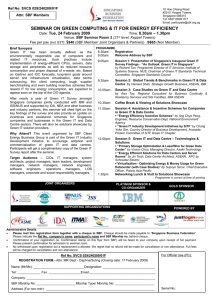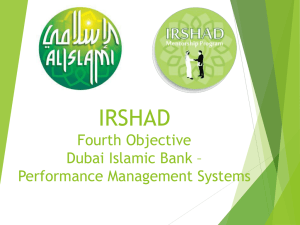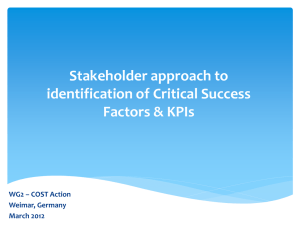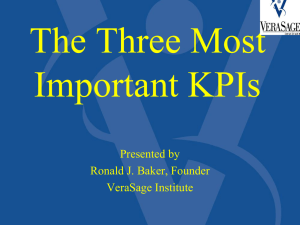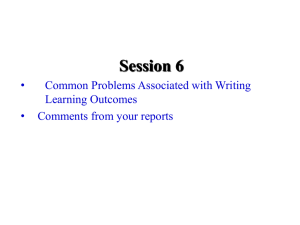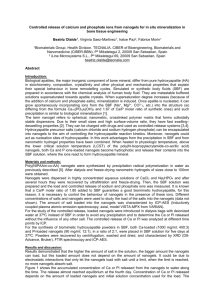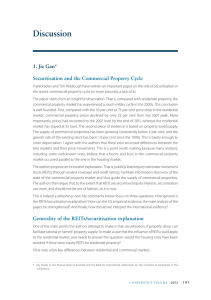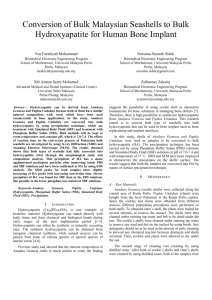Existe-t-il une relation entre l*information sectorielle et le tableau
advertisement
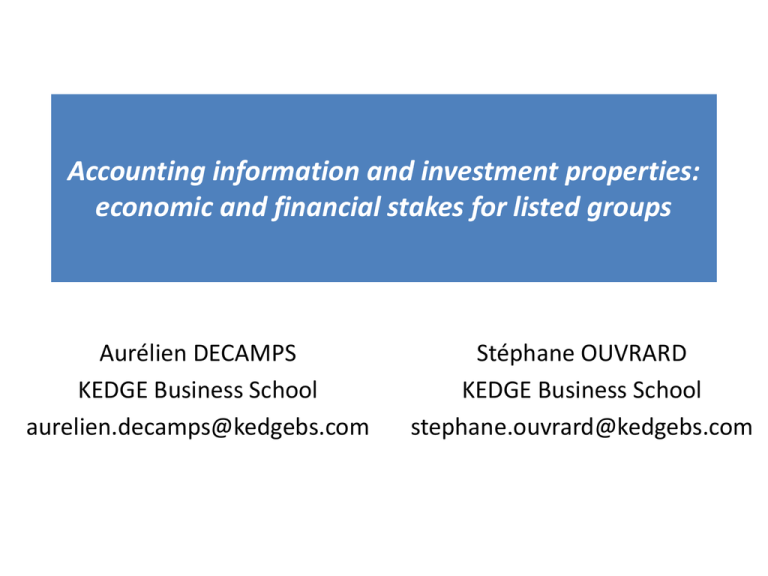
Accounting information and investment properties: economic and financial stakes for listed groups Aurélien DECAMPS KEDGE Business School aurelien.decamps@kedgebs.com Stéphane OUVRARD KEDGE Business School stephane.ouvrard@kedgebs.com Research Question Does accounting choice for corporate investment property have an impact on economic and financial disclosures for listed companies ? Aim • Understand accounting companies concerning property choice of listed their investment • Estimate the impact of this choice on their consolidated financial statement Presentation • Background – Investment property in a corporate context – Accounting choice for investment property • Empirical study – Investment property of listed groups (SBF 120) • Method • Results • Conclusion Background Investment property in a corporate context • Financialization of corporate property in the french context – Value creation from corporate property (NappiChoulet et al., 2009) • Outsourcing / sale and leaseback: core business and debt reduction strategies from firms • Fast development of french REITs (SIIC since 2002) – Financial approach and asset management applied to corporate property (Simon, Malle, 2009) Background Investment property in a corporate context • IFRS Standards (January 1st 2005) – Owner-occupied property (IAS 16) vs. Investment Property (IAS 40) – Measurement at the Fair Value: financial approach based on actuarial assumptions Background Investment property in a corporate context Investment Property according to IAS 40: "Property (land or a building or part of a building or both) held (by the owner or by the lessee under a finance lease) to earn rentals or for capital appreciation or both" Fair Value according to IAS 40: “The amount for which the property could be exchanged between knowledgeable, willing parties in an arm's length transaction" Background Accounting choice for investment property IAS 40 : Choice between two accounting methods o Historical Cost Referring to accumulated depreciation o Fair Value Mark to Market referring to market value Mark to Model referring to appraisal methods such as capitalization rate or discounted cash flow Background Accounting choice for investment property Initial measurement (acquisition of the property) • Historical cost • Acquisition cost = purchase price + costs directely allocated to the real estate asset Further measurement (reporting date) • Choice (option): historical cost or fair value • The accounting option chosen must be implemented to all the investment properties in a same category Consequences (fair value as an option) • The fair value changes (gains or losses) are recorded in the Income Statement (profit or loss) • This fair value change is shown in the « other operating income & expenses " item Background Accounting choice for investment property Pros & Cons of Fair Value Pros Cons o Give a further information to reduce agency costs. o Source of volatility and of shortterm vision (Bloomfield, Nelson, Smith, 2006). o Protect against the excess of Creative Accounting (Casta and Colasse, 2001). o Step closer Accounting and Corporate Finance. o Procyclical phenomenon amplifying the changes in the assets/liabilities values at the same pace as the economic cycle (Escaffre, Foulquier, Touron, 2008). oProcyclical and self-fulfilling feature of fair value (Morand and Marteau, 2010). Background Accounting choice for investment property Historical Cost vs. Fair Value o Two opposed models (historical cost / fair value) that raise the question of relevance vs reliability of financial information. o The historical cost model is relatively reliable insofar as under this accounting method the cost of an asset/liability is verifiable and as there are few risks of estimation error. o That is not the case for the value in use (IFRS 13, level 3) that is based on calculation coming from actuarial assumptions. o Conversely, the relevance of fair-value accounting is generally better than when the accounts are valued on a historical cost basis (Scott, 2009). Two main hypothesis Hypothesis 1: As investment property is the core business of REITs, they should adopt a financial approach and choose the Fair Value Model to measure investment properties. Whereas companies not primarily in the real estate business should adopt the cost model to measure their investment property in order to avoid the procyclical effect of fair value. Hypothesis 2: Fair Value may have a pro-cyclical effect, allowing better KPIs (Key Performance Indicators) through profitability, rentability and solvency ratios in the context of an increasing cycle of the market. Whereas, it may deteriorate KPIs when the market is in a decreasing cycle. Empirical Study SBF 120 listed companies -Sample: 20 companies listed on SBF 120 which own investment properties -Method: -Analysing financial annual statement of each company - Activity sector - Accounting choice for investment property - Weigt of investment properties in the total capital - KPIs (Key Performance Indicators) -MCA (Multiple Correspondance Analysis) to map correlations between these quantitative and qualitative dimensions. -Variance analysis to estimate the impact of the accounting choice on the financial KPIs of REITs. Empirical Study SBF 120 listed companies Table 2: Depiction of the quantitative variables Variable Definition Total capital Total capital = Total assets = total equity & liabilities % Total capital Weight of property investments in the total capital SA Sales NPM Net Profit Margin = Net Income (part of the group) / Sales AT ROA ROE Assets Turnover = Sales / Total capital Return on Assets = Net Income (part of the group) / Total capital Return on Equity = Net Income (part of the group) / Shareholders' Equity Average Standard deviation 3895,147 6741,041 0,314 0,408 13691,947 22652,167 15,334 29,192 45,542 51,405 3,049 5,059 7,857 10,572 141,360 159,764 Gearing Gearing = Net Financial Debts* / Shareholders' Equity ER Equity ratio = Shareholders' Equity / Total capital 28,799 17,018 OPM Operating Profit Margin = Operating Profit** / Sales 37,016 45,534 4,651 3,960 0,791 46,681 39,850 3,957 10756,000 9076,739 73,380 39,376 0,408 7,860 17,625 10,141 7,125 6,664 ICR ICF % SA Interest Coverage ratio = Financial expenses / EBITDA*** Investing cash flow / Sales Spécifiques aux sociétés foncières LTV RP EPRA ANAV EPRA ANAV change Return on investment Loan to Value = Net Financial Debts/ Properties Fair value Reevalued Property**** Adjusted Net Asset Value (EPRA model) Change of EPRA ANAV (2012/2011) Number of references in the annual report / registration document Number of references in the annual report / registration Vacancy rate document *Total financial debts – Cash & cash equivalents. **EBIT: Earnings Before Interests and Taxes. ***Earnings Before Interests Depreciation and Amortization. ****Fair value of the property assets. 3ème partie - Etude empirique: les groupes cotés du SBF 120 Empirical Study SBF 120 listed companies Table 3: Influence of the accounting choice on the quantitative variables. Financial Performance Banking Covenants Property investments Asset Turnover Gearing Equity ratio Operating profit margin Reevalued property EPRA ANAV Fair value Return on investment Vacancy rate Contribution of the inter- Correlation groups variance to the total (/1) variance (%) 37,58 0,61 19,35 0,44 31,18 0,56 39,5 0,63 33,93 0,58 34,18 0,58 43,68 0,66 27,64 0,53 63,35 0,80 Conclusion This explanatory study highlights two main results: • The Fair Value model is a way to improve financial statement as it influences KPIs. However, the value of investment property is closely linked to market cycle generating procyclical effects. • The accounting choice of REITs in our sample is balanced between historical cost and fair value. It may be interpreted as a prudential behaviour due to this procyclical effect. Research Perspectives A wider sample of REITs should improve our results: • Confirm the impact of the Fair Value model on financial KPIs • Link the accounting choice of investment property to the REITs’ business model Thank you for your attention

